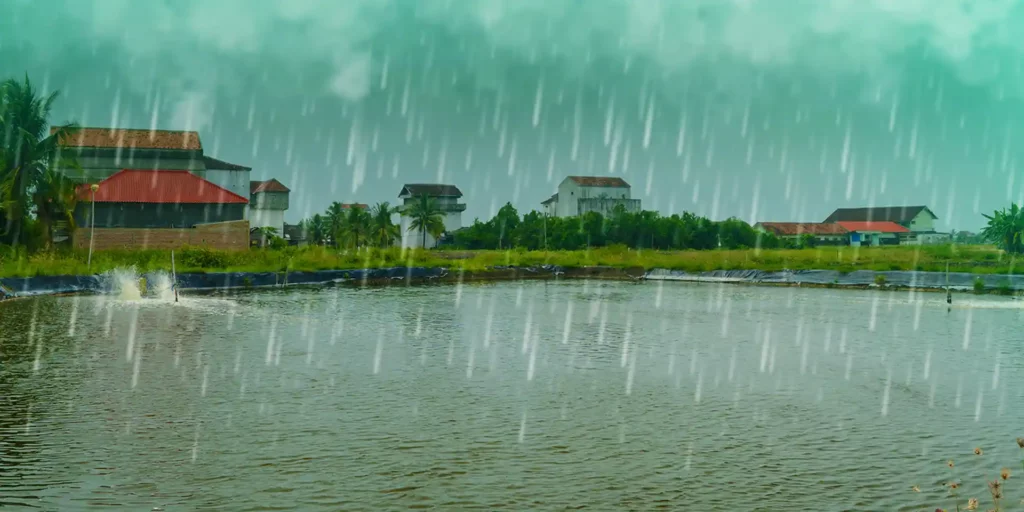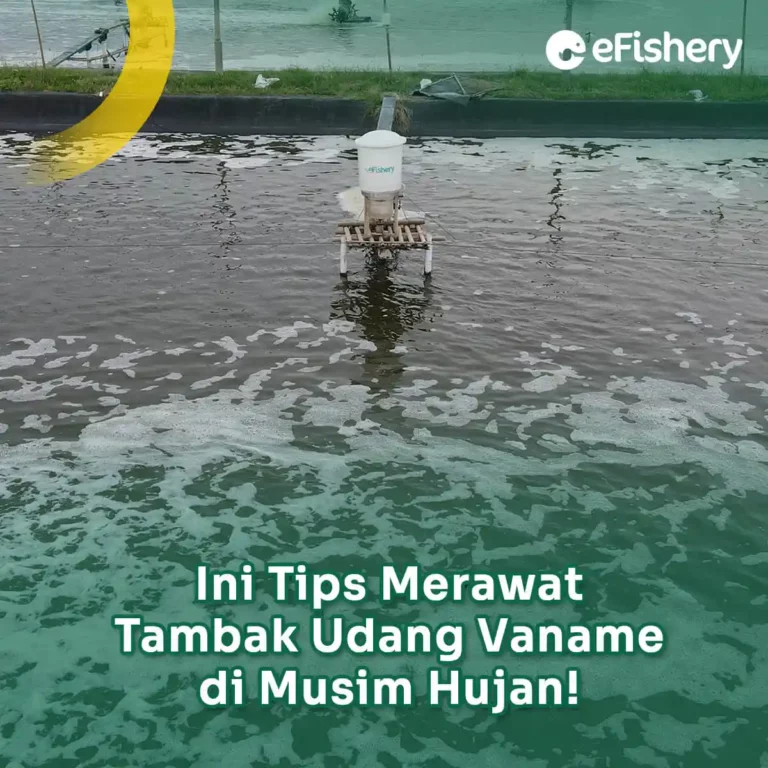Artikel Ini Telah Direview Oleh:

Anggie Nur
Magister Bioteknologi
Rainfall can quickly change the production conditions for vannamei shrimp ponds which are less than optimal, so that the growth of shrimp is hampered. Rain is often followed by significant changes in temperature, salinity, pH and dissolved oxygen.
Another physical change that is directly related to rain is an increase in suspended solids due to the transport of soil material from pond levy. This higher pond turbidity negatively affects sunlight penetration and causes a sudden collapse of phototrophic populations.
Seeing that there are many risks and threats lurking for farmers in the rainy season, let's look at the following tips for caring for vannamei shrimp ponds in the rainy season.
As a result of the Vaname Shrimp Ponds being exposed to continuous rain

Vaname shrimp (Litopenaeus vannamei) has the advantage of fast growth and can live with high stocking densities, but is susceptible to significant changes in water quality parameters. Water quality that changes drastically when it rains will make the vannamei shrimp weak, stressed, and even die. There are two effects if the vaname shrimp pond is exposed to continuous rain, namely:
1. Immediate Effect
Rainwater generally has a temperature of 5-6°C lower than water in the vaname shrimp pond environment. In addition to causing a decrease in temperature, continuous rain will have an impact on decreasing pH, salinity and oxygen in the pond due to the addition or dilution of water. This condition is dangerous for shrimp, if not handled immediately it will cause shrimp metabolism to increase and shrimp to be easily exposed to stress.
2. Indirect Effects
The indirect effects felt were a decrease in the concentration of micro and macro minerals, an increase in turbidity, a reduction in the intensity of the sun, and a decrease in the population of heterotrophic bacteria. The role of heterotrophic bacteria in shrimp ponds is to break down organic matter and dead algae cells that settle on the bottom of the pond.
If rain occurs continuously, the heterotrophic bacteria will decrease. When it rains, usually DO will decrease because shrimp metabolism has increased due to decreased temperature, pH and salinity, resulting in competition for dissolved oxygen between shrimp and other organisms. Oxygen is needed by heterotrophic bacteria to process organic matter, if heterotrophic bacteria die due to lack of oxygen, there will be an increase in organic matter which will harm the shrimp.
Tips for Caring for Vaname Shrimp Ponds in the Rainy Season
Vannamei shrimp farmers must have corrective and regular actions in processing vannamei shrimp ponds in the rainy season. Here are tips for caring for vannamei shrimp ponds in the rainy season:
1. Before the Rain Falls
Farmers can do the following things before it rains:
- Use weather forecasts to monitor local weather conditions.
- Clean and enlarge the drainage channels. In some cases, you may need to install a pumping station at one end of the drainage canal to drain rainwater mechanically when the river level exceeds the drainage level.
- Make sure all aeration equipment and electrical settings are functioning properly.
- Have an electric generator ready in case of a power outage due to heavy rain.
- Prepare calcium carbonate and potassium chloride. In case of rain, sprinkle calcium carbonate (500 kg/ha) and potassium chloride (100 kg/ha).
2. When It Rains
Farmers can do the following when it rains:
- Continuous DO and pH control. If the pH drops, give calcium carbonate.
- Reduce feeding to 70% from normal ration, and continue to reduce according to temperature and DO data.
- Turn on all available mechanical aerators and try to keep the DO level above 4 ppm at all times.
- Control the health of microalgae in shrimp aquaculture waters by observing samples using a microscope. Healthy algal cells have a full central vacuole and no separation between the cell wall and membrane. Algal death can be prevented by changing the pool water to reduce the density of algae cells and by increasing the pH.
3. When the Rain Stops
Farmers can do the following after the rain stops:
- Take temperature, pH, and DO samples to reconfirm the estimated shrimp population after the rain event. Daily population sampling should be carried out at least a week after.
- Add vitamin C, potassium, sodium and magnesium salts before feeding.
- Add probiotics to prevent unwanted bacterial domination and increase the rate of decomposition and nitrification. This method can also inhibit the growth of pathogens in vannamei shrimp ponds.
- Maintain a high level of aeration until there is a stable population of new microalgae in the pond.
Get Optimal Shrimp Cultivation Advice in the Rainy Season with eFarm!
Need Help Regarding Shrimp Cultivation Business?
Fill in your personal data in the following form. Our team will immediately contact you via the number cellphone attached. Make sure the data entered is correct.
To get the right water quality treatment steps in the rainy season, you can consult the experts in the feature Cultivation Consultation in application eFarm. eFarm is an application for shrimp farmers that provides various solutions in managing ponds, with complete features for controlling water quality to caring for your shrimp ponds.
What are you waiting for? Enjoy the convenience of cultivating shrimp together eFarm. Consult your pond problems for FREE in the application eFarm Now!

Anggie Nur - Magister Bioteknologi
Anggie merupakan lulusan sarjana dan magister bioteknologi serta memiliki pengalaman riset di dunia perikanan khususnya udang
Questions Regarding Tips for Caring for Vaname Shrimp Ponds in the Rainy Season
When the rainy season arrives, you can clean and enlarge the drainage canals, continuously control DO and pH, and reduce feeding to 70% from normal rations.
You can reduce feeding up to 70% from normal rations, and continue to reduce it according to temperature and DO data. Continuous DO and pH control. If the pH drops, give calcium carbonate.
- Supriatna, Mahmudi M, Musa M, Kusriani. 2020. Correlation between Ph and Water Quality Parameters in Vannamei Shrimp (Litopenaeus Vannamei) Intensive Ponds. Department of Water Resources Management, Faculty of Fisheries and Marine.
- Sutiknowati L. 2014. Quality of Shrimp Pond Waters Based on Microbiological Parameters. Journal of Tropical Marine Science and Technology. Volumes 6(1):157-170.
